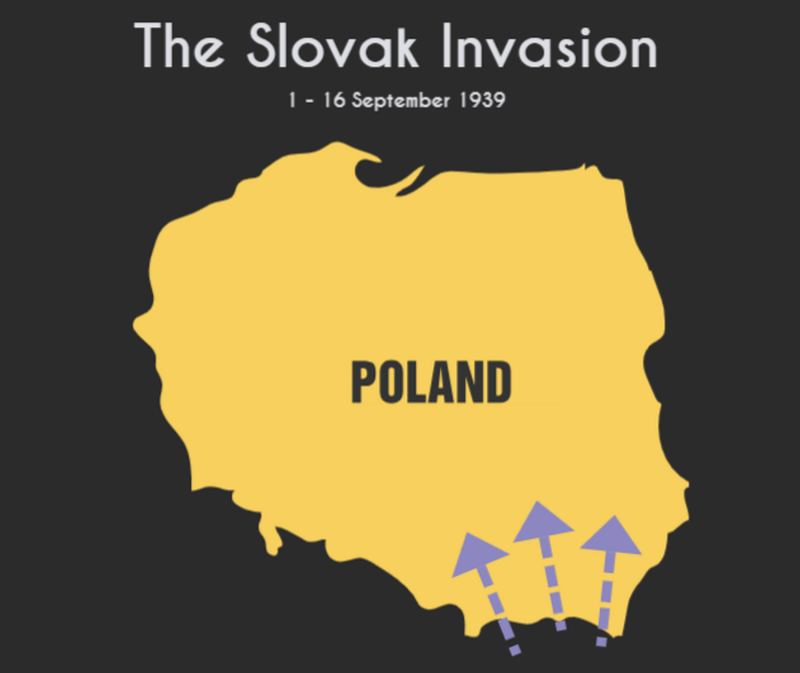Slovak Invasion
In September 1939, as Nazi Germany launched its brutal invasion of Poland, the recently-formed Slovak Republic joined in the attack. Field Army Bernolák, comprised of three divisions and boasting over 50,000 soldiers, was unleashed upon the hapless Poles.
With most of the Polish forces preoccupied with the German armies advancing from the north, the Slovak invasion met only feeble resistance. The result was a swift and devastating victory, with the Slovaks suffering minimal losses in the process.
While the Slovak contribution to the invasion may have been small in comparison to the German war machine, it nonetheless served as a stark reminder of the dangers of collaboration with tyrants and aggressors. The Slovaks may have believed that their actions would bring them closer to their German allies, but in reality, they only served to further embolden the Nazi war machine and bring untold suffering to the people of Poland.
As the world looked on in horror at the unfolding events in Poland, it became clear that the invasion was not just an attack on a sovereign nation, but an assault on the very values of freedom, democracy, and human dignity. The Slovak invasion may have been a minor footnote in the larger conflict, but it was a dark chapter in the history of a nation that had once fought for its own independence and freedom.
The Slovak plans
In March 1939, the Slovak State was created under the thumb of Germany, prompting the partition of Czechoslovakia. The region of southern Slovakia, home to a significant Hungarian population, had previously been part of the Kingdom of Hungary, and was annexed by the Royal Hungarian Army following the First Vienna Award in November 1938.
The official justification for Slovakia's involvement in the Polish Campaign was a disputed territory along the Poland-Slovakia border. This land had been seized by Poland on October 1, 1938, following the Munich Agreement the previous month. Furthermore, some Polish leaders supported Hungary's efforts to incorporate areas with a mostly Hungarian population.
In July 1939, during confidential talks with Germany, the Slovak government agreed to participate in Germany's upcoming invasion of Poland and to permit Germany to use Slovak territory as a staging ground for its troops.
On August 26, Slovakia mobilized its armed forces and created a new field army, codenamed "Bernolák," with 51,306 soldiers. Additionally, 160,000 reservists were called up, with 115,000 being drafted by September 20, 1939.
Under the command of Slovak Defence Minister Ferdinand Čatloš, the Bernolák army group was established and headquartered in Spišská Nová Ves. It was composed of three infantry divisions and a motorized unit: the 1st Infantry Division "Jánošík" led by Anton Pulanich, the 2nd Infantry Division "Škultéty" led by Alexander Čunderlík, the 3rd Infantry Division "Rázus" led by Augustín Malár, and the motorized unit "Kalinčiak" which was not deployed in time for the campaign.
The group was integrated into the German Army Group South and was subordinate to the 14th Army, led by Wilhelm List. The 14th Army was comprised of five infantry divisions, three mountain divisions, two panzer divisions, and one Luftwaffe division. The Bernolák army group's mission was to prevent a Polish attack into Slovakia and provide support to German troops.
Their opposition came from the Polish Karpaty Army, which primarily consisted of infantry units with light artillery support but lacked tanks.
The battle commences
At dawn on September 1, 1939, without any formal declaration of war, the Bernolák army group launched its attack. Led by the 1st Infantry Division "Jánošík", the Slovak forces quickly seized the village of Javorina and the town of Zakopane, before advancing towards Nowy Targ to support the German 2nd Mountain Division on their left flank. Javorina was located in the area between Zakopane and Nowy Targ, and was strategically important as it was situated on the German-Polish border.
The 1st Division engaged in combat with regular Polish Army units on September 4 and 5, and by September 7, it had reached 30 kilometers into Polish territory, where it came to a stop. Eventually, the division was pulled back, with one battalion remaining until September 29 to occupy Zakopane, Jurgów, and Javorina.
Meanwhile, the 2nd Division remained in reserve and only participated in mopping-up operations, assisted by the Kalinčiak group. The 3rd Division, tasked with guarding a vast stretch of the Slovak border between Stará Ľubovňa and the Hungarian border, encountered only minor skirmishes and advanced into Polish territory. By September 11, the division had ended its advance.
In addition to ground troops, the Slovak air squadrons Ľalia and Lily were utilized for reconnaissance, bombing, and close support for German fighters. However, two Slovak planes were lost—one to anti-aircraft fire and another to an accidental crash—while the Slovak forces shot down one Polish plane. All told, the Slovak losses during the campaign amounted to 37 dead, 114 wounded, and 11 missing.
Aftermath
Following their withdrawal at the end of September 1939, the Slovak Army celebrated a triumphant military parade on October 5 in Poprad. The mobilized units were subsequently demobilized, with Army Group Bernolák disbanded on October 7.
As part of their campaign, the Slovak Army took approximately 1,350 civilian prisoners in Poland. In February 1940, the Germans were given around 1,200 prisoners, while the remainder were handed to the Soviets or kept in a Slovak prison camp in Lešť.
All disputed territory, whether from 1920 or 1938, was ultimately given to Slovakia as confirmed by a Slovak parliamentary resolution on December 22, 1939. However, this was only temporary, and on May 20, 1945, the border was returned to its 1920 position. Since there was no formal declaration of war and no Polish prisoners of war held by Slovakia, there was no formal peace treaty between Poland and Slovakia.
Soldiers of the Slovakian Army being decorated by Slovak Minister of Defence, Ferdinand Čatloš after the Invasion of Poland.
Wikipedia

